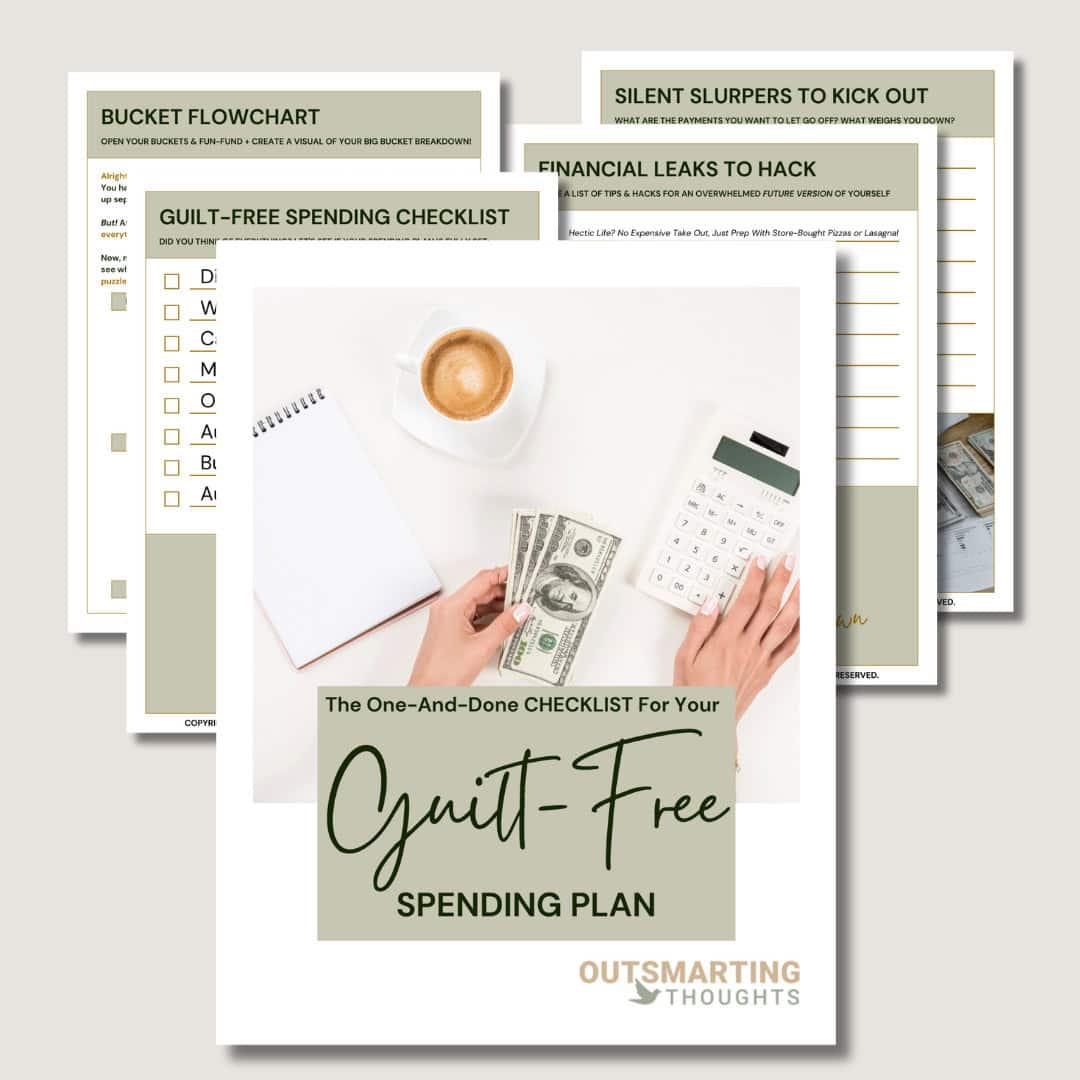Let’s talk about impulse buying examples that hit way too close to home. This post is dedicated to decoding the emotional chaos behind your most common impulse purchases; so you can outsmart them instead of waking up with regret and a shrinking bank balance.
You’re not weak or reckless. But if you’ve ever looked at your online order history and thought, what the hell was I trying to fix with that? You’re not alone. We overachievers often tell ourselves we’re too strategic to fall for emotional spending. Yet the truth is: when your brain is running on fumes, self-doubt, or bottled-up emotion, your cart becomes your comfort zone. And so, you’re not buying stuff. You’re buying relief.
What you’re going to learn is how four everyday impulse purchases are actually coded emotional signals. You’ll learn to decode them like a CEO, call out your unmet needs, and shift toward healthier, strategic behavior that actually builds the life you want.
After you have learned to spot the emotional trigger behind your go-to impulse buys, you’ll be able to fight back against the pattern & hit pause before your card hits the scanner. You’ll start acting out of clear-headed rationality instead of burnout-mode desperation. And seriously, that’s when your choices start aligning with the version of you who doesn’t half-ass life.
This post is all about impulse buying examples so you can stop being prey for marketeers and start living like you’re in charge.
Impulse Buying Examples
Impulse buying is about way more than just impulsivity. When you observe the pattern more deeply, it’s way more about who’s really driving your behavior: your emotion or your intention. If emotion is in the driver’s seat 99% of the time, it’s not surprising your wallet feels hijacked, right?
Most impulse buys are emotional band-aids; tiny moments of self-medication. That doesn’t mean you’re broken. It means you’re a normal, decent, feeling human being who’s trying to cope. But without clear-headed rationality and self-leadership, those coping moments can get really, really expensive. And guess who profits from your lack of awareness? The billion-dollar masterminds who know exactly how to bait your brain.
If you’re tired of being stuck in that trap, read on. These four wildly relatable examples will show you what you’re really craving when you spend without thinking; and how to get it in a way that actually feels good, lasts longer, and helps you build something real.
Why “That Checkout Candy Bar” Isn’t About Sugar
There’s a reason that mini snack aisle exists right where you’re forced to stand still and stare: it’s built for tired brains on autopilot. When you’re stressed, overstimulated, or emotionally fried, your brain wants one thing: dopamine. And it doesn’t want to wait. In fact, it’s hardly a matter of choice anymore, it’s NOT CAPABLE of waiting… That’s why the candy bar ends up on the belt, even when you’re not hungry. It’s not about food. It’s about escaping the worn-out feeling & pain of now.
RELATED POST:
Psychological Reasons For Overspending & How To Outsmart Them (Spoiler Alert: It’s Not YOUR Fault!)
Impulse buying at checkout is one of the most obvious emotional spending examples; but it’s also one of the least acknowledged. You might brush it off as a small splurge, but when this behavior repeats, it reveals a deeper loop. You’re in chronic micro-escape mode. Your body is screaming for rest or relief, and your brain is outsourcing that job to whatever’s within arm’s reach.
Let’s not sugarcoat it: you don’t need more snacks. You need to pause, recharge, and deal with your actual stress. Start seeing the checkout trap as a dopamine dose alert. That tiny craving? It’s your nervous system waving a white flag. Don’t answer it without negotiating! Answer it with a strategy like a loving parent would outsmart it’s impulsive kid: caretake it with sleep, movement, space to think, or yes; a better snack plan. But do it on your terms, AND with self-control as counterweight.
Why The Posture Gadget You Never Used Wasn’t About Posture
You didn’t buy that self-cleaning bottle or posture trainer because you couldn’t live without it, right? You bought it because it whispered promises of becoming a future version of yourself. One who finally drinks enough water. One who sits tall, radiates energy, and doesn’t feel like a crumpled-up adult by 3PM. You bought a shortcut to your dream.
Impulse tech purchases like these are less about need and more about transformation. They speak directly to the overachiever’s fantasy self: organized, put-together, on top of everything. But let’s move past fluff & flaky wishful thinking: buying the gadget doesn’t make you that person. Becoming that person does.
So next time you feel the itch to tap “Buy Now” on a sleek piece of lifestyle tech, ask yourself: are you solving a problem you actually have; or just trying to skip the real work of habit change? Answer it with a strategy like a strategic CEO would outsmart it’s naieve employees, and take care of it with changing the environment and/or strategy. Because the future you doesn’t need gadgets to fake it. She needs systems to make it.
Owning a cashflow strategy is a skill that’ll give you some serious advantages in life. I think budgeting is an aligned action with taking life seriously, and I seriously believe life will reward you for it. If you’re not into high-maintenance strategies like ‘tracking your spending’ and just want to sit down ONCE to direct your financial future, our Guilt-Free Spending Plan Printable is the right cashflow strategy for you! Don’t let anybody outsmart you out of your own money and start budgeting today by simply filling out the form below:

Want a free
ONE-AND-DONE CHECKLIST for aGUILT-FREE SPENDING PLAN? Free up your bandwidth and stop overthinking with this
FREE One-And-Done Checklist for your Guilt-Free Spending Plan!
Simply fill out the form below to get this strategy
delivered straight to your inbox!
Why That Limited Edition Drop Wasn’t Just Cute, It Was About Belonging
FOMO marketing should really never be underestimated, because it really works! You see the words “only 500 made” and the primal part of your brain goes from casual scroll to checkout panic in under 60 seconds. Suddenly, it’s not about whether you need that makeup palette or hoodie. It’s about not being left behind.
Limited-edition impulse buys are pure emotional bait. And what they’re really selling you isn’t the item itself. It’s a ticket into a tribe; a fast-track to mattering & feeling significant again. But when you’re buying out of that pressure to feel included, you’re not acting from power. You’re acting from self-abandonment.
RELATED POST:
How To Stop Overspending: The Strategy You NEED To Regain Control (Without The Self-Blame Spiral)
You don’t need to keep up with the crowd to prove you matter. When you feel the heat of limited-time drops, hit pause and ask: Am I buying because this aligns with me? Or because I’m scared of missing out on being someone? The market plays dirty with your pride. But you? You’re not here to be average. You’re here to build something real; and that requires you to rebel against emotional scarcity and start acting like you know your worth. Reparent your insecurities & lack of belonging, and you’ll outsmart this pattern in no-time!
That Candle Set Wasn’t Self-Care, It Was a Cry for Rest
You lit the candle, journaled once, then forgot about it. Sound familiar? That “self-care” impulse buy wasn’t actually about rest. It was a cry for it. When you’re burned out but still pushing through, your brain will throw any tool into the cart that even resembles relief. And before you hop on the negative self-talk bandwagon, STOP! You’re not lazy. You’re running on fumes and trying to patch a leak with vibes.
Impulse buying self-care items is one of the most misleading behaviors because it feels aligned. But what I would like you to consider is this: if you’re buying stuff to care for yourself but never actually using it, you’re not practicing self-care. You’re outsourcing it without management.
You don’t need more wellness kits. You need permission to stop. To rest, recharge, and reassess where your energy is leaking. The candle isn’t the cure. YOU ARE. Give yourself 30 minutes of undisturbed space before you ever open your browser. Let your nervous system feel heard; not just scented. You got this!
Impulse Buying Examples (Summary)
Impulse buying is often framed as a lack of willpower; but honestly, it’s way more about emotional turbulence and unaddressed stress. Your nervous system needs relief. Your body wants rest. And marketing masterminds are more than happy to sell you a (fake) shortcut if it keeps you small, distracted, and easy to manipulate.
The key strategies in this post? Learning to decode four specific impulse buys: snacks for stress relief, gadgets for fulfilling the fantasy with a shortcut, limited FOMO drops for belonging, and self-care tools as burnout band-aids. Once you decode the emotional trigger, you can replace the purchase with something that truly satisfies the core emotional need.
Imagine a life where you don’t feel yanked around by your urges. You spot the trigger. You name the need. And you respond like the CEO of your own nervous system. That’s what it means to live awake, with intention and energetically aligned. That’s what it means to stop half-assing life.
I wish you the guts to pause, the energy to dig deeper, and the self-respect to intentionally spend your money in ways that move your life forward, not just numb your way through it. Go kick ass.
This post was all about impulse buying examples so you can stop being prey for marketeers and start living like you’re in charge.
We aim to help you out as much as possible, but please keep in mind that the content is only for general informational and educational purposes. We offer our services based on independent research and life-experience only, and so our strategies can never serve as a substitute for professional advice. Trust me, we do not have 'everything figured out', are all still huge works in progress, but hey, what works for us, might work for you too! This is allll up for you to decide... It might not work for you, and that's okay, so cherrypick the stuff that resonates and leave the stuff that doesn't, and let's go!








